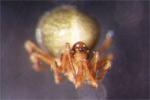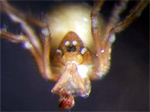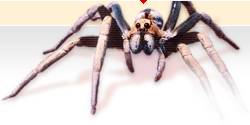
Holarchaeid Spiders
Holarchaeidae Forster & Platnick, 1984
(compiled by Michael G. Rix, with photographs by the author)
Identification
 opens in new window
opens in new window
from Lake Waikaremoana,
New Zealand
Holarchaeid spiders share a number of characters that readily separate them from all other spiders. They are very small in size (less than 1.5mm in body length), and shiny black, brown, olive or beige in colour. They possess a distinctly raised and clearly demarcated pars cephalica (head region) bearing eight eyes and relatively few setae; in Holarchaea globosa (Hickman, 1981) the carapace is triangular in lateral profile. The chelicerae are elongate, and project out of a foramen in the front of the cephalothorax; this foramen is incompletely surrounded by sclerotised cuticle, with unsclerotised cuticle ventrally. The chelicerae have two to three true teeth and long, curved fangs. The clypeus is swollen, projecting anteriorly above the chelicerae. The legs are relatively short, and the tarsi are distinctly longer than the metatarsi. The abdomen is spherical, with very thin cuticle, and six spinnerets. The male pedipalp is with or without prominent cymbial apophyses, and the female genitalia are entelegyne, with globular receptacula. The unique combination of a ventrally unsclerotised cephalothoracic foramen plus entelegyne female genitalia separates the Holarchaeidae from all other families.
Biology
 opens in new window
opens in new window
Holarchaea sp. (left) and
male Holarchaea globosa (right)
Holarchaeid spiders are known only from the forests of Tasmania and New Zealand, where they live in microhabitats with consistently high humidity. Holarchaea globosa lives on the fronds of the low-growing ‘hard water fern’ (Blechnum wattsii) in dark, wet Antarctic Beech forests in Tasmania, and has also been collected from caves (Rix, 2005). In New Zealand, specimens have been collected from moss, leaf litter and ferns. Very little is known of the biology of Holarchaeidae, and most species are rare.
Araneidae in Australasia
 opens in new window
opens in new window
globosa, frontal view
Only two holarchaeid species have been described from Australasia, although there are undescribed species known from New Zealand. Both species are placed in the genus Holarchaea Forster, 1955.
Australia
Only a single holarchaeid species, Holarchaea globosa (Hickman, 1981), is known from Australia and Rix (2005) gives a summary of the taxonomy and the known biology of this species.
New Zealand
Only a single holarchaeid species is described from New Zealand – Holarchaea novaeseelandiae (Forster, 1949) – although there are undescribed species known from both the North and South Islands, and offshore islands, e.g. Stewart Island.
South-east Asia
Holarchaeid spiders are not known from South-east Asia.
References
Forster, R. R. (1949). New Zealand spiders of the family Archaeidae. Records of the Canterbury Museum 5: 193-203.
Forster, R. R. (1955). Spiders of the family Archaeidae from Australia and New Zealand. Transactions of the Royal Society of New Zealand 83: 391-403.
Forster, R. R. and Platnick, N. I. (1984). A review of the archaeid spiders and their relatives, with notes on the limits of the superfamily Palpimanoidea (Arachnida, Araneae). Bulletin of the American Museum of Natural History 178: 1-106.
Hickman, V. V. (1981). New Tasmanian spiders of the families Archaeidae, Cycloctenidae, Amaurobiidae and Micropholcommatidae. Papers and Proceedings of the Royal Society of Tasmania 115: 47-68.
Rix, M. G. (2005). A review of the Tasmanian species of Pararchaeidae and Holarchaeidae (Arachnida, Araneae). The Journal of Arachnology 33: 135-152.

